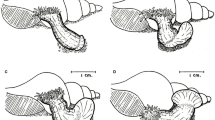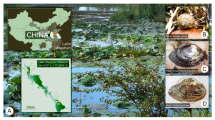Abstract
Coloniality among rotifers is rare, and while the adaptive significance of the lifestyle has been explored previously, there are few details about how it may have influenced the morphology of colony members. In this study, we use confocal laser scanning microscopy combined with cyto- and immunohistochemistry to determine if the colonial rotifer, Sinantherina socialis, differs in neuromuscular organization relative to other colonial and solitary forms. Our observations indicate that the patterns of serotonergic neurons and somatic muscles in S. socialis are broadly similar to other rotifers. At the neuronal level, the distribution of serotonergic (5HT-IR) neurons in S. socialis is most similar to colony-forming species of Conochilus: (1) paired nerve cords extend the length of the body; (2) the cerebral ganglion innervates the corona with paired neurites that form a neuronal ring; and (3) a single pair of neurites innervates the ventral sensory antennae. Unique to S. socialis is the presence of two additional neuronal rings that supply the corona and may function to modulate ciliary beat. At the muscular level, S. socialis displays a typical pattern of somatic muscle organization similar to other rotifers, but diverges from the pattern in three significant ways: (1) somatic circular muscles form complete rings; (2) circular muscles are distinguishable based on their size and position in the body; and (3) transverse muscles are present within the corona and presumably function to modify its shape for feeding and defensive purposes. These differences in neuromuscular organization may be adaptations to the colonial and/or sessile lifestyle, both of which are characteristic of S. socialis.





Similar content being viewed by others
References
Arndt H (1993) Rotifers as predators on components of the microbial web (bacteria, heterotrophic flagellates, ciliates)—a review. Hydrobiologia 255–256:231–246
Champ P, Pourriot R (1977) Particularites biologiques et ecologiques du rotifere Sinantherina socialis (Linne). Hydrobiologia 55:55–64
Diéguez M, Balseiro E (1998) Colony size in Conochilus hippocrepis: defensive adaptation to predator size. Hydrobiologia 387–388:421–425
Felix A, Stevens ME, Wallace RL (1995) Unpalatibility of a colonial rotifer, Sinantherina socialis, to small zooplaktivorous fishes. Invert Biol 114:139–144
Fontaneto D, Melone G, Wallace RL (2003) Morphology of Floscularia ringens (Rotifera, Monogononta) from egg to adult. Invert Biol 122:231–240
Garcia MA (2004) The asexual life history of the colonial rotifer, Sinantherina socialis (Linnaeus). Dissertation, Yale University, Connecticut, 129 pp
Gilbert JJ (1987) The Polyarthra escape response: defense against interference from Daphnia. Hydrobiologia 147:235–238
Gilbert JJ, Waage JK (1967) Asplanchna, Asplanchna-Substance, and posterolateral spine length variation of the rotifer Brachionus calyciflorus in a natural environment. Ecology 48:1027–1031
Hay-Schmidt A (2000) The evolution of the serotoninergic nervous system. Proc R Soc Lond B 267:1071–1079
Hlava S (1905) Beiträge zur Kenntnis der Rädertiere: über die Anatomie von Conochiloides natans. Z Wiss Zool 80:282–326
Hochberg R (2006) On the serotonergic nervous system of two planktonic rotifers, Conochilus coenobasis and C. dossuarius (Monogononta, Flosculariacea, Conochilidae). Zool Anz 245:53–62
Hochberg R (2007) Topology of the nervous system of Notommata copeus (Rotifera: Monogononta) revealed with anti-FMRFamide, -SCPb, and -serotonin (5-HT) immunohistochemistry. Invert Biol 126(3):247–257
Hochberg R, Ablak Gurbuz O (2007) Functional morphology of somatic muscles and anterolateral setae in Filinia novaezealandiae Shiel and Sanoamuang, 1993 (Rotifera). Zool Anz 246:11–22
Hochberg R, Ablak Gurbuz O (2008) Comparative morphology of the somatic musculature in species of Hexarthra and Polyarthra (Rotifera): its function in appendage movement and escape behavior. Zool Anz 247:233–248
Kotikova EA (1995) Localization and neuroanatomy of catecholaminergic neurons in some rotifer species. Hydrobiologia 313(314):123–127
Kotikova EA (1997) Localization of catecholamines in the nervous system of Transversiramida. Dokl Russ Acad Sci 353:841–843
Kotikova EA (1998) Catecholaminergic neurons in the brain of rotifers. Hydrobiologia 387(388):135–140
Kotikova EA, Raikova OI, Flyatchinskaya LP, Reuter M, Gustafsson MKS (2001) Rotifer muscles as revealed by phalloidin-TRITC staining and confocal scanning laser microscopy. Acta Zool 82:1–9
Kotikova EA, Raikova OI, Reuter M, Gustafsson MKS (2004) Musculature of an illoricate rotifer Asplanchnopus multiceps as revealed by phalloidin fluorescence and confocal microscopy. Tissue Cell 36:189–195
Kotikova EA, Raikova OI, Reuter M, Gustafsson MKS (2005) Rotifer nervous system visualized by FMRFamide and 5-HT immunohistochemistry and confocal laser scanning microscopy. Hydrobiologia 546:239–248
Leasi F, Ricci C (2010) Musculature of two bdelloid rotifers, Adineta ricciae and Macrotrachela quadricornifera: organization in a functional and evolutionary perspective. J Zool Syst 48:33–39
Leasi F, Pennati R, Ricci C (2009) First description of the serotonergic nervous system in a bdelloid rotifer: Macrotrachela quadricornifera Milne 1886 (Philodinidae). Zool Anz 248:47–55
Lewontin RC (1970) The units of selection. Annu Rev Ecol Syst 1:1–18
Riemann O, Wilts EF, Ahlrichs WH, Kieneke A (2009) Body musculature of Beuchampiella eudactylota (Gosse, 1886) (Rotifera: Euchlanidae) with additional new data on its trophi and overall morphology. Acta Zool 90:265–274
Santo N, Fontaneto D, Fasio U, Melone G, Caprioli M (2005) External morphology and muscle arrangement of Brachionus urceolaris, Floscularia ringens, Hexarthra mira and Notommata glyphura (Rotifera, Monogononta). Hydrobiologia 546:223–229
Segers H (2007) Annotated checklist of the rotifers (Phylum Rotifera) with notes on nomenclature, taxonomy and distribution. Zootaxa 1564:1–104
Segers H, Wallace RL (2000) Phylogeny and classification of the Conochilidae (Rotifera, Monogononta, Flosculariacea). Zool Scripta 30:37–48
Sørensen MV (2005a) Musculature in three species of Proales (Monogononta, Rotifera) stained with phalloidin-labeled fluorescent dye. Zoomorphology 124:47–55
Sørensen MV (2005b) The musculature of Testudinella patina (Rotifera: Flosculariacea), revealed with CLSM. Hydrobiologia 546:231–238
Vidrine MF, McLaughlin RE, Willis OR (1985) Free-swimming colonial rotifers (Monogononta: Flosculariacea: Flosculariidae) in southwestern Louisiana Rice Fields. Freshw Invert Biol 4:187–193
Wallace RL (1987) Coloniality in the phylum Rotifera. Hydrobiologia 147:141–155
Wallace RL, Snell TW, Ricci C, Nogrady T (2006) Rotifera: volume 1: biology, ecology and systematics, 2nd edn. Backhuys Publishers, Leiden
Walsh EJ, Salazar M, Remirez J, Moldes O, Wallace RL (2006) Predation by invertebrate predators on the colonial rotifer Sinantherina socialis. Invert Biol 125:325–335
Weiger W (1997) Serotonergic modulation of behaviour: a phylogenetic overview. Biol Rev 72:61–95
Williamson C (1983) Invertebrate predation on planktonic rotifers. Hydrobiologia 104:385–396
Wilts EF, Ahlrichs WH, Martinez Arbizu P (2009) The somatic musculature of Bryceella stylata (Milne, 1886) (Rotifera: Proalidae) as revealed by confocal laser scanning microscopy with additional new data on its trophi and overall morphology. Zool Anz 248:161–175
Acknowledgments
We thank two anonymous reviewers for improving the quality of this manuscript. We also thank Julie Piraino of the Smithsonian Marine Station in Fort Pierce, FL and Earl Ada of the Materials Characterization Lab at the University of Massachusetts Lowell (UML) for their assistance with SEM. This research was supported by a UML Faculty-Student Collaborative Research grant. This is Smithsonian Marine Station at Fort Pierce Contribution # 825.
Author information
Authors and Affiliations
Corresponding author
Additional information
Communicated by T. Bartolomaeus.
Rights and permissions
About this article
Cite this article
Hochberg, R., Lilley, G. Neuromuscular organization of the freshwater colonial rotifer, Sinantherina socialis, and its implications for understanding the evolution of coloniality in Rotifera. Zoomorphology 129, 153–162 (2010). https://doi.org/10.1007/s00435-010-0108-6
Received:
Revised:
Accepted:
Published:
Issue Date:
DOI: https://doi.org/10.1007/s00435-010-0108-6




